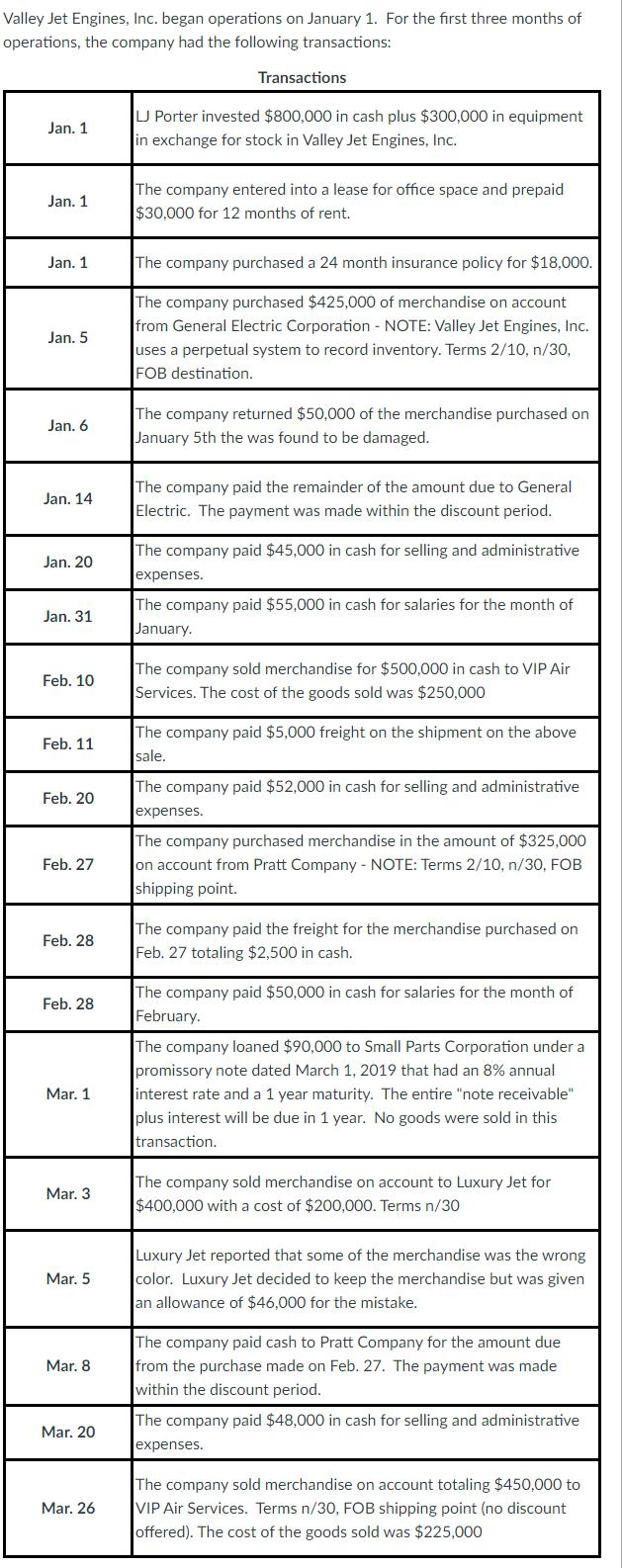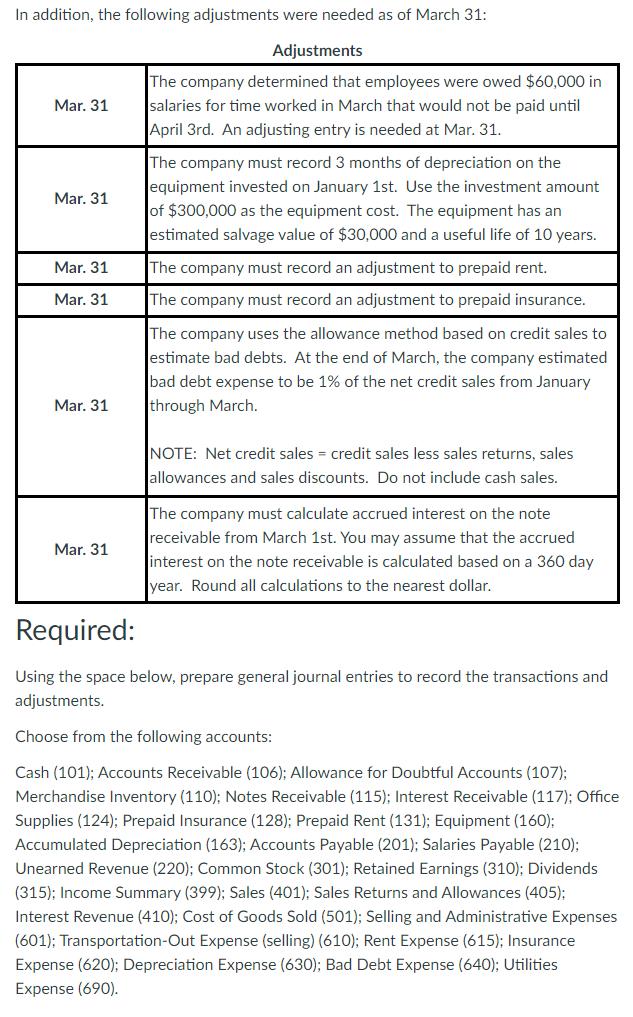Answered step by step
Verified Expert Solution
Question
1 Approved Answer
Valley Jet Engines, Inc. began operations on January 1. For the first three months of operations, the company had the following transactions: Jan. 1


Valley Jet Engines, Inc. began operations on January 1. For the first three months of operations, the company had the following transactions: Jan. 1 Jan. 1 Jan. 1 Jan. 5 Jan. 6 Jan. 14 Jan. 20 Jan. 31 Feb. 10 Feb. 11 Feb. 20 Feb. 27 Feb. 28 Feb. 28 Mar. 1 Mar. 3 Mar. 5 Mar. 8 Mar. 20 Mar. 26 LJ Porter invested $800,000 in cash plus $300,000 in equipment in exchange for stock in Valley Jet Engines, Inc. Transactions The company entered into a lease for office space and prepaid $30,000 for 12 months of rent. The company purchased a 24 month insurance policy for $18,000. The company purchased $425,000 of merchandise on account from General Electric Corporation - NOTE: Valley Jet Engines, Inc. uses a perpetual system to record inventory. Terms 2/10, n/30, FOB destination. The company returned $50,000 of the merchandise purchased on January 5th the was found to be damaged. The company paid the remainder of the amount due to General Electric. The payment was made within the discount period. The company paid $45,000 in cash for selling and administrative expenses. The company paid $55,000 in cash for salaries for the month of January. The company sold merchandise for $500,000 in cash to VIP Air Services. The cost of the goods sold was $250,000 The company paid $5,000 freight on the shipment on the above sale. The company paid $52,000 in cash for selling and administrative expenses. The company purchased merchandise in the amount of $325,000 on account from Pratt Company - NOTE: Terms 2/10, n/30, FOB shipping point. The company paid the freight for the merchandise purchased on Feb. 27 totaling $2,500 in cash. The company paid $50,000 in cash for salaries for the month of February. The company loaned $90,000 to Small Parts Corporation under a promissory note dated March 1, 2019 that had an 8% annual interest rate and a 1 year maturity. The entire "note receivable" plus interest will be due in 1 year. No goods were sold in this transaction. The company sold merchandise on account to Luxury Jet for $400,000 with a cost of $200,000. Terms n/30 Luxury Jet reported that some of the merchandise was the wrong color. Luxury Jet decided to keep the merchandise but was given an allowance of $46,000 for the mistake. The company paid cash to Pratt Company for the amount due from the purchase made on Feb. 27. The payment was made within the discount period. The company paid $48,000 in cash for selling and administrative expenses. The company sold merchandise on account totaling $450,000 to VIP Air Services. Terms n/30, FOB shipping point (no discount offered). The cost of the goods sold was $225,000 In addition, the following adjustments were needed as of March 31: Adjustments The company determined that employees were owed $60,000 in salaries for time worked in March that would not be paid until April 3rd. An adjusting entry is needed at Mar. 31. Mar. 31 Mar. 31 Mar. 31 Mar. 31 Mar. 31 Mar. 31 The company must record 3 months of depreciation on the equipment invested on January 1st. Use the investment amount of $300,000 as the equipment cost. The equipment has an estimated salvage value of $30,000 and a useful life of 10 years. The company must record an adjustment to prepaid rent. The company must record an adjustment to prepaid insurance. The company uses the allowance method based on credit sales to estimate bad debts. At the end of March, the company estimated bad debt expense to be 1% of the net credit sales from January through March. NOTE: Net credit sales = credit sales less sales returns, sales allowances and sales discounts. Do not include cash sales. The company must calculate accrued interest on the note receivable from March 1st. You may assume that the accrued interest on the note receivable is calculated based on a 360 day year. Round all calculations to the nearest dollar. Required: Using the space below, prepare general journal entries to record the transactions and adjustments. Choose from the following accounts: Cash (101); Accounts Receivable (106); Allowance for Doubtful Accounts (107); Merchandise Inventory (110); Notes Receivable (115); Interest Receivable (117); Office Supplies (124); Prepaid Insurance (128); Prepaid Rent (131); Equipment (160); Accumulated Depreciation (163); Accounts Payable (201); Salaries Payable (210); Unearned Revenue (220); Common Stock (301); Retained Earnings (310); Dividends (315); Income Summary (399); Sales (401); Sales Returns and Allowances (405); Interest Revenue (410); Cost of Goods Sold (501); Selling and Administrative Expenses (601); Transportation-Out Expense (selling) (610); Rent Expense (615); Insurance Expense (620); Depreciation Expense (630); Bad Debt Expense (640); Utilities Expense (690).
Step by Step Solution
★★★★★
3.54 Rating (161 Votes )
There are 3 Steps involved in it
Step: 1
Answers and Explanation Jan 1 Debit Cash 101 800000 Debit Equipment 160 300000 Credit Common Stock 3...
Get Instant Access to Expert-Tailored Solutions
See step-by-step solutions with expert insights and AI powered tools for academic success
Step: 2

Step: 3

Ace Your Homework with AI
Get the answers you need in no time with our AI-driven, step-by-step assistance
Get Started


